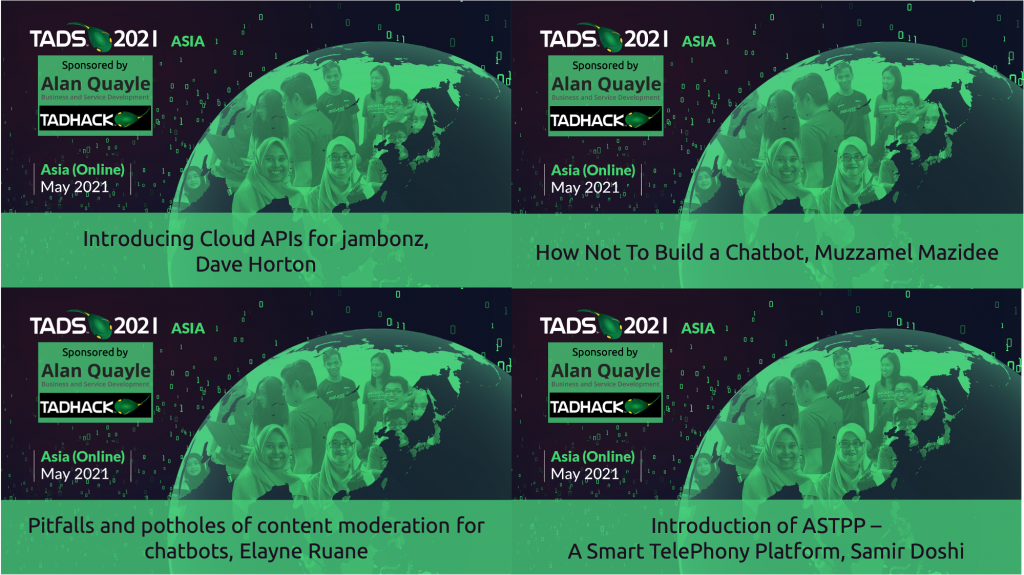“Wait a minute,” I hear you say. “Where’s Friday’s installment of TADSummit Asia?” Like all good things, or like buses, we’re going to have to wait until next week when potentially 7 presentations will come along at once 🙂
The full TADSummit Asia 2021 agenda is here. Week 3 delivered, with presentations you’ll not hear at any of the, “everything is awesome big brand events.” From the programmable communications industry-wide disruption of Dave Horton’s Cloud APIs for Jambonz; the critical gap in content moderation across most chatbots by Elayne Ruane; to how NOT to build a chatbot from Mel of UIB, and the unique open source billing project ASTPP led by Samir.
Introducing Cloud APIs for jambonz, Dave Horton
Click on the title to go to the weblog with the video, slides, outline, review and Q&A. Please like and share the videos, slides and weblog; we need your help to get the message out.
Dave kicks off by referencing Dan Jenkins’ excellent TADSummit EMEA Americas 2020 presentation, “The Difference Between Your Project Succeeding or Burning To A Crisp Is Actually You.” Where Dan highlighted the importance of taking a leaf out of Element‘s book – make it extremely simple to sign up to the project’s cloud platform. And that’s just what Dave has done.
I love the frank review Dave provides on the challenges of completing this “last mile” of the project. It’s not as fun as building the core, and it has a significant opportunity cost and out of pocket expenses. This is often why commercial organizations sweep in and use a project to help create multi-tens of billions businesses with little to no kick-back to the project.
The demo Dave provides of setting up Jambonz is amazing, just watch the video. In just a few minutes he has a full voice-centric CPaaS operational and running live services. Having helped many companies through this process over the years, this is revolutionary. Please join Dave’s private beta of Cloud APIs for jambonz by contacting him here. You’ll be glad you did.
Pitfalls and potholes of content moderation for chatbots, Elayne Ruane
Moderation is more than a social media chat room problem. Its an issue for any brand using a chatbot to engage with its customers and prospects. Google has a team dedicated to it within their AI Ethics.
Even if you choose to constrain the bot space to only respond to specific intents with a limited vocabulary, the training data generated still needs work. And remember those chatbot interactions are public, they can and will be recorded, and potentially make their way onto social media.
Elayne provides excellent advice on managing moderation:
- Thoughtful design is important (legally, morally, commercially…)
- Protecting the user is #1 – give users recourse and the benefit of the doubt
- Your chatbot is just ones and zeros but your team are people!
Thank you Elayne for an insightful presentation on Chatbot Moderation. I hope you’ve raised the TADSummit community’s awareness of this critically important and under-discussed topic.
How Not To Build a Chatbot, Muzzamel Mazidee
I love this quote he uses at the end, “One reason a chatbot takes more effort than either self-service or a human agent is that compared to us humans, it’s stupid.” Thank you Mel for one of the best bot implementation guides I’ve ever seen.
Mel runs through what bot implementations get wrong, this is spot-on and excellent insight:
- Users’ needs. If the bot cannot help the customer get to want they want faster / easier than what you’re doing today. Don’t do it, as it will frustrate the customer. If you’re going to send your customers to watch a video for 10 minutes, make sure this will resolve their problem. After 10 minutes and an unresolved problem, the customer is now furious at your brand/business for wasting their time.
- KPIs, tracking, and ROI. It takes time to fine-tune the bot to the specific application — test, test, test. Without metrics, the project cannot develop towards delivering business results and customer satisfaction.
- Users’ favorite channels and preferred languages. I cannot overstate the importance of this. Asia is the most diverse region for channels and languages.
- It’s “dumb.” The bot can’t handle multiple intents/languages.
- It’s not used. Some of the initial HR and FAQ bots suffered from this as the user volumes were low and/or user benefits slight. If it doesn’t benefit the customer, they will not use it.
Introduction of ASTPP – A Smart TelePhony Platform, Samir Doshi
Billing is one of those functions that catches many service providers by surprise. “We have a real-time usage dashboard, we can convert that into real-time billing easily.” Or, “we’ll do a monthly invoice based on the spreadsheet we can create for each customer’s usage.”
Soon new services, use cases, credits and discounts, product codes, and reporting appear requiring updates to the now legacy billing platform. The company starts to feel like it’s turned into a billing platform maintainer; where the biggest gate on the product roadmap is billing. It’s surprising we’ve not seen more open source billing projects like ASTPP.
Samir runs through the capabilities and some of the deployments of ASTPP. It’s a nice evolution of how a service provider may start with SIP trunking, then add multi-tenant IP PBX, and then interconnect as the business scales.
The scale of ASTPP surprised me, it supports 13 languages, and has 11k+ deployments across 95 countries. Please check out ASTPP.
Please like and share the videos, slides and weblog; we need your help to get the message out on this excellent content the programmable communications industry needs to know! Thank you.


One thought on “Weekend Insights from Week 3 of TADSummit Asia 2021”
Comments are closed.